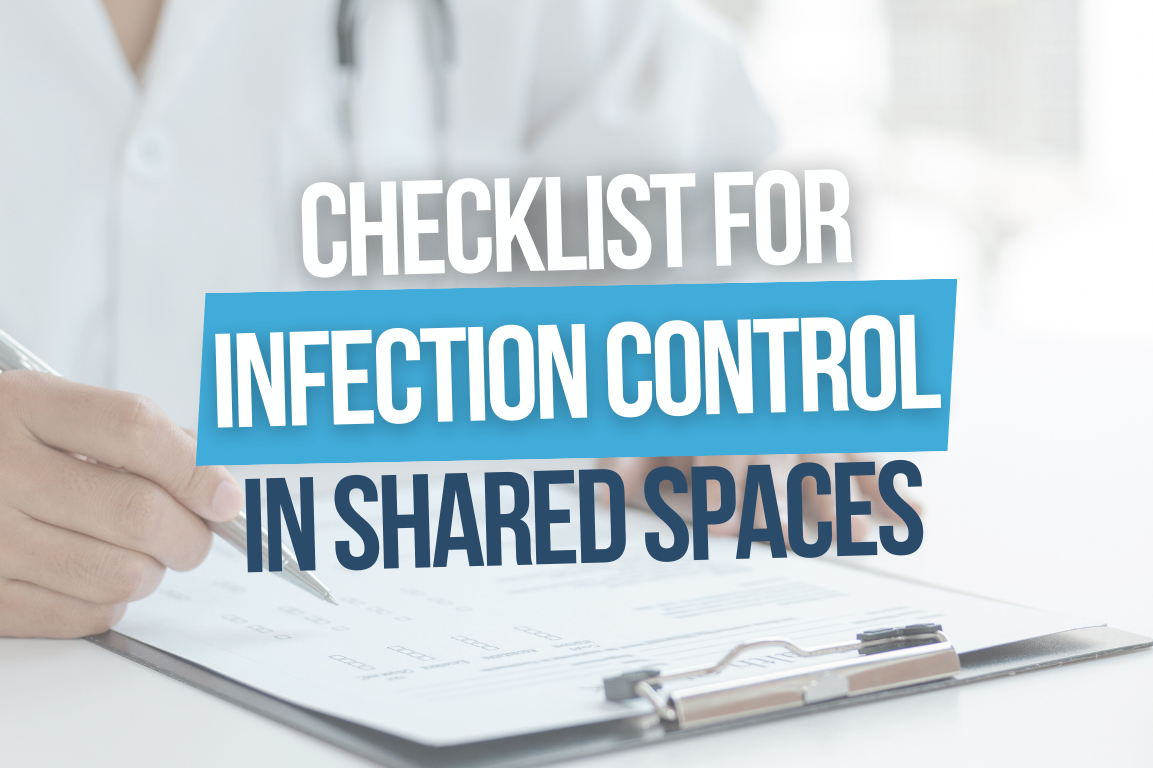Checklist for Infection Control in Shared Living Spaces

Shared living spaces can quickly become hotspots for infections. To keep everyone safe, you need a clear plan focused on hygiene, screening, and disinfection. Here's what matters most:
- High-Risk Areas: Bathrooms, kitchens, and common areas require frequent cleaning. Bedding and laundry handling are critical points for preventing cross-contamination.
- Entry Screening: Use no-touch thermometers and symptom checklists to monitor residents and visitors. Keep a centralized log for tracking.
- PPE and Hygiene: Provide masks, gloves, and sanitizer at all key locations. Train staff on proper use.
- Disinfection: Clean high-touch surfaces multiple times daily with EPA-approved disinfectants. Use color-coded tools to avoid cross-contamination.
- Bedding Solutions: Disposable options like PeelAways sheets simplify cleanup and reduce infection risks.
- Air Quality: Ensure proper ventilation and consider HEPA filters or UV-C systems to reduce airborne pathogens.
- Outbreak Response: Act quickly by isolating cases, increasing cleaning, and keeping families informed.
These steps help create safer spaces for everyone. Start with entry screening and hygiene, then build a routine for cleaning and monitoring.
Chapter 3 - Control Infection & Cross Contamination
Entry Screening and Personal Protective Equipment (PPE)
Effective entry screening and readily available PPE help reduce the risk of contaminated individuals entering shared spaces.
Daily Screening Procedures
Use no-touch infrared thermometers to check the temperature of everyone entering the facility. A reading of 100.4°F or higher should be flagged. Record key details like names, temperatures, symptoms, and screening times in a centralized log to monitor potential outbreak patterns.
Ask specific questions about symptoms such as fever, cough, shortness of breath, loss of taste or smell, body aches, or gastrointestinal issues. Avoid vague inquiries like "Are you feeling well?" Instead, use direct prompts like "Have you had a fever in the past 24 hours?" or "Are you experiencing any difficulty breathing?" This approach ensures more accurate symptom reporting and creates a reliable record for tracking trends.
PPE Availability and Access
Place medical-grade masks, disposable gloves, and hand sanitizer (with at least 60% alcohol) at all entrances and high-traffic areas. Train staff on the proper way to put on and remove PPE to minimize contamination risks.
Restock supplies twice a day during peak traffic times to avoid shortages. Set up PPE stations in high-risk locations like outside bathrooms, near dining areas, and at the entrances to residents' rooms. Each station should include gloves in various sizes, masks, and hand sanitizer.
Signage and Instructions
Use standardized signage to guide visitors and staff. For example, design "stop" signs for high-risk zones and "yield" signs for moderate-risk areas. Include clear instructions like "Mask Required" or "Use Hand Sanitizer Before Entry." Place these signs 10–15 feet ahead of screening stations for better visibility, and replace them promptly if they become faded or damaged[1].
Avoid overwhelming spaces with too many signs, as this can dilute their impact. Digital displays can also be useful for safety messaging, offering dynamic content and interactive options[2]. Keep the language simple and direct to prevent confusion.
Communication is critical - nearly 70% of medical errors stem from communication breakdowns[3]. Clear, up-to-date signage plays a vital role in maintaining safety and ensuring that everyone understands the protocols.
These entry measures form a key part of the broader infection control strategy, supporting hygiene and disinfection efforts throughout the facility.
Hygiene and Surface Disinfection
Maintaining hygiene and thorough disinfection is key to preventing infections in shared spaces. These efforts, paired with entry screening and the use of personal protective equipment (PPE), help create a safer environment for everyone.
Hand Hygiene Stations
Hand hygiene is one of the simplest yet most effective defenses against infection. To support this, place hand sanitizer dispensers at key transition points, such as entrances, hallways, and near shared equipment. Make sure these dispensers are accessible to everyone, including individuals using wheelchairs.
Install visual guides near sinks to demonstrate proper handwashing techniques. Highlight the 20-second rule by suggesting easy-to-remember tips, like singing the "Happy Birthday" song twice. For environments where simplified instructions are helpful, consider using picture-based guides to make the process clearer.
Keep dispensers stocked at all times by checking and refilling them regularly. Always have extra supplies ready to avoid running out.
Cleaning and Disinfection Schedule
Focus on disinfecting high-touch surfaces like doorknobs, light switches, handrails, elevator buttons, and shared equipment multiple times a day. Use EPA-approved disinfectants, following recommended concentrations - such as 70% isopropyl alcohol or properly diluted sodium hypochlorite solutions.
Adopt a zone-based cleaning system with color-coded tools to prevent cross-contamination between areas. Maintaining a visible cleaning log can help track tasks, ensure accountability, and support compliance checks.
Don’t overlook porous surfaces like upholstered furniture and carpets, which can harbor pathogens for longer periods than hard surfaces. High-temperature steam cleaning is an effective way to sanitize these materials. Regular deep cleaning of soft furnishings is also a good practice to minimize risks.
Staff Training on Disinfection
Equip your cleaning staff with the knowledge and skills they need to follow proper disinfection protocols. This includes understanding the correct contact times for disinfectants and learning how to dilute concentrated cleaning products safely and effectively. Using solutions that are too weak or too strong can compromise both safety and cleaning outcomes.
Schedule regular competency checks to ensure staff are following correct procedures. Provide hands-on training for safely putting on and removing PPE, as this is critical for their protection. Offering clear guidelines and open communication can also help address any concerns staff may have, especially in high-pressure cleaning roles.
Proper training not only boosts confidence but also ensures these essential measures are carried out effectively.
Resident Care and Bedding Solutions
Managing infection control in shared living spaces requires more than just surface disinfection. Ensuring residents' well-being involves a thoughtful approach to health monitoring, bedding management, and the safe handling of contaminated materials. These practices play a key role in maintaining a safe and hygienic environment.
Health Screening for Residents
A thorough health screening process is essential for new admissions and returning residents. Check for symptoms like fever, cough, or shortness of breath, and document findings in each resident's health record. Any concerning signs should be flagged for immediate medical attention. These steps work hand-in-hand with daily entry screenings.
Daily temperature and symptom checks are a must, and staff should be trained to recognize early signs of infections that can spread quickly in communal settings. For residents returning from hospital visits or medical appointments, consider a 24- to 48-hour observation period to monitor for potential symptoms of exposure.
Keep vaccination records up to date, including flu vaccines, COVID-19 boosters, and other recommended immunizations for group living environments. A centralized vaccination database can help medical staff access this information quickly during assessments.
Benefits of Disposable Bedding
Traditional bedding can pose challenges for infection control, especially in shared spaces. Contaminated linens require multiple handling steps - removal, transport, and laundering - all of which increase the risk of cross-contamination.
PeelAways disposable bed sheets offer a smart alternative. These sheets feature a multi-layer design with a waterproof barrier that prevents fluids from seeping through. Cleanup is simple: just peel away the soiled top layer to reveal a clean sheet underneath. No need for mattress lifting or laundry processing.
The waterproof barrier is especially important because mattresses can harbor pathogens for extended periods and are difficult to disinfect thoroughly. With sizes ranging from toddler to King, these sheets provide an efficient and cost-effective solution for facilities of all kinds. By reducing the time spent on bedding management, staff can focus more on direct resident care while maintaining strict hygiene standards.
Safe Handling of Soiled Bedding
Whether using traditional or disposable bedding, proper handling of soiled materials is critical. Always wear PPE when dealing with contaminated linens. For traditional bedding, immediately place soiled items in labeled, leak-proof bags. With disposable bedding, simply remove the contaminated layer and discard it in designated waste containers. Follow the correct PPE removal process and wash hands thoroughly afterward.
For traditional linens, separate heavily soiled items from lightly soiled ones, labeling each bag with the date and contamination level. Use dedicated carts for transport, and disinfect them after each use. Disposable bedding eliminates many of these steps, but staff should still practice good hand hygiene after handling any soiled materials.
When transporting contaminated items, use low-traffic routes to minimize exposure risks. Designate well-ventilated storage areas for soiled linens, ensuring these spaces are easy to access for laundry pickup. Clean and disinfect these storage areas daily, and make sure they have proper drainage to maintain hygiene standards.
sbb-itb-45288fe
Physical Distancing and Common Area Management
Careful planning can go a long way in managing overcrowding and reducing the risk of infections. Regularly reviewing resident participation also helps maintain safety in shared spaces, working hand-in-hand with other infection control strategies.
Managing Shared Facilities
One effective approach is to use staggered scheduling. By dividing residents into smaller groups, you can control the flow of people, minimize congestion, and allow enough time for thorough cleaning between sessions.
Activity planning software can make this process even smoother. It helps coordinate schedules, adapt to changing needs, and offer a variety of activities. A diverse activity lineup ensures residents are spread across different spaces and times, keeping shared areas less crowded [4][5][6].
Monitoring attendance and analyzing participation trends can also guide adjustments to session sizes and capacity limits. This ensures that shared facilities remain accessible without becoming overcrowded.
Additionally, providing multiple formats for activities - such as virtual sessions or outdoor options - can ease the demand on indoor common areas, offering residents more flexibility while maintaining safety.
Monitoring, Reporting, and Outbreak Response
Keeping a close eye on infections and acting quickly can prevent outbreaks from spreading through a facility. For instance, dormitories show a 27.5% positivity rate for secondary SARS-CoV-2 transmission, which is more than double the 12.6% rate seen in households [7]. This highlights how critical active monitoring and fast responses are in shared living spaces.
Infection Tracking and Surveillance
Beyond basic hygiene, consistent monitoring plays a vital role in spotting and controlling infections early. Daily temperature checks and symptom screenings, supported by digital tools, can help detect patterns that might signal an outbreak.
Temperatures should be recorded twice a day, flagging any readings above 100.4°F (38°C). Symptom checklists should cover respiratory issues, digestive problems, and mental status changes. Keeping detailed logs of resident interactions and shared activities aids in contact tracing if infections arise. Research shows that around 10–20% of infected individuals are responsible for 80% of COVID-19 transmission, often in crowded or poorly ventilated areas [8].
Reporting Procedures
Clear reporting protocols are essential for meeting local health department requirements and ensuring timely responses. In many areas, suspected or confirmed cases of reportable infectious diseases must be reported within 24 hours.
Assign specific staff members to serve as the main points of contact with public health authorities. These individuals should stay updated on local guidelines and reporting criteria. Accurate documentation is crucial - this includes details like resident demographics, symptom onset dates, possible exposure sources, and isolation status. A well-organized chain of communication ensures that department heads and administrators receive timely updates, enabling coordinated decision-making. These measures directly feed into outbreak response efforts, ensuring swift and organized action.
Outbreak Response Plans
When multiple cases surface in a short time, quick and decisive action is essential. Local public health agencies are typically best equipped to lead outbreak investigations due to their familiarity with community-specific needs [8].
Immediately isolate affected residents, restrict movement within the facility, and enforce strict PPE protocols for staff working in impacted areas. Assign clear roles for assessing the situation and communicating updates to residents, families, and staff. Frequent cleaning of high-touch surfaces and temporarily closing common areas for deep sanitization may also be necessary.
To minimize cross-contamination, consider staffing adjustments - dedicate "clean" teams to unaffected areas and "dirty" teams to isolation zones. Tools like PeelAways disposable bed sheets can further reduce contamination risks. These sheets feature a multi-layer design that allows caregivers to peel away soiled layers, revealing a clean sheet underneath. This eliminates the need to lift mattresses, reduces laundry demands, and helps maintain hygiene during outbreaks.
Keeping families informed is equally important. Regular updates about the facility’s status, visitor limitations, and residents’ health can help build trust and maintain transparency, especially when in-person visits are restricted.
Even during an active outbreak, it’s important to plan for recovery. Set clear criteria for lifting restrictions, resuming regular operations, and conducting post-outbreak evaluations to improve future response strategies.
Waste Management and Environmental Controls
Managing waste effectively and ensuring proper ventilation are crucial for reducing the spread of pathogens in shared living spaces. By addressing these two areas, facilities can significantly lower the risk of infections.
Medical Waste Disposal
Items contaminated with blood, bodily fluids, or infectious agents should always be treated as medical waste. These materials must be handled by licensed medical waste disposal companies. It's essential to train staff to distinguish between medical waste and regular trash to avoid improper disposal.
Provide puncture-resistant, leak-proof, and clearly labeled sharps containers in all relevant areas, and replace them before they reach capacity. Staff should never attempt to force items into a full container or retrieve items from one.
Use separate, clearly marked containers for different types of waste, including regular trash, medical waste, and recyclables. Prompt disposal of these materials is critical to maintaining a safe environment.
While licensed medical waste haulers typically operate on set schedules, facilities should prepare for emergencies, especially during outbreaks when waste volumes may spike. Emergency pickup services can be a backup option when regular pickups cannot meet demand.
Once waste is securely managed, attention should turn to maintaining high indoor air quality.
Indoor Air Quality Improvement
Controlling air quality is just as important as waste management when it comes to preventing infections. Start by ensuring that ventilation systems meet recommended standards throughout the facility. In areas where ventilation may be insufficient, portable HEPA air purifiers can provide additional support.
HEPA filters are highly effective, capturing 99.97% of particles as small as 0.3 micrometers, including many bacteria and viruses. To maintain their effectiveness, ensure regular filter replacements and routine maintenance.
Maintaining indoor humidity between 40% and 60% is another key factor. Humidity levels below 40% can dry out respiratory membranes, making individuals more susceptible to infections, while levels above 60% can encourage mold and bacterial growth, creating additional health risks.
Additional steps to improve air quality include:
- Using natural ventilation when conditions allow.
- Installing UV-C light systems in HVAC ducts to neutralize pathogens.
- Monitoring CO₂ levels to ensure proper air exchange, aiming to keep levels below 1,000 ppm.
Regular maintenance of air handling systems is non-negotiable. This includes cleaning ductwork, replacing filters on schedule, and calibrating monitoring systems. During outbreaks, consider increasing the frequency of these checks and using temporary solutions like portable air scrubbers to enhance air quality further.
Conclusion: Key Takeaways for Infection Control
Maintaining effective infection control in shared spaces requires everyone on the team to stay vigilant and follow precise measures to minimize the spread of disease.
Final Checklist Highlights
Focus on three main pillars: preventing entry of infections, keeping the environment clean, and using personal protective equipment (PPE) correctly. As discussed earlier, proper screening and thorough disinfection are essential to keeping facilities safe.
Bedding management is particularly prone to cross-contamination. Traditional methods of handling bedding often increase this risk. PeelAways disposable bed sheets offer a practical solution with their peel-away design, allowing caregivers to quickly remove soiled layers to reveal a fresh one underneath. This approach eliminates the need to lift mattresses, reduces laundry demands, and minimizes the chances of spreading infections between individuals.
Ensure air handling systems are well-maintained by using UV-C light and conducting regular inspections to optimize air quality. For medical waste, use puncture-resistant, leak-proof containers and ensure disposal is handled by licensed professionals to prevent contamination risks.
These steps provide a solid starting point for practical infection control measures.
Implementation Guidance
Start applying these measures right away to protect your facility. Begin with high-priority actions like entry screening and promoting proper hand hygiene. Train your staff thoroughly so they understand both the procedures and why they are important.
Keep detailed documentation of cleaning schedules, screening outcomes, and any incidents. This not only helps identify trends but also proves compliance with regulations and supports ongoing improvements to your infection control efforts.
Tailor these guidelines to fit your facility’s specific needs. For instance, smaller facilities might need to adjust cohorting strategies, while larger ones could require more frequent air quality checks or additional screening points. The goal is to maintain consistent practices while staying adaptable to unique challenges.
Regularly review and update your infection control program. Schedule periodic evaluations, gather feedback from staff to address any practical difficulties, and stay informed about the latest recommendations from health authorities. Remember, infection control isn’t a one-time task - it’s a continuous process that evolves over time.
FAQs
What are the best practices for entry screening in shared living spaces to reduce infection risks?
To reduce the risk of infections in shared living spaces, it's important to screen for symptoms like fever, cough, or any other signs of illness at the point of entry. Tools like temperature checks and quick health questionnaires can help spot potential cases early. It's equally crucial to encourage both staff and residents to promptly report if they experience any symptoms.
For extra precaution, set up clear guidelines for isolating individuals who show symptoms. At the same time, emphasize preventive practices such as staying up to date with vaccinations, frequent handwashing, and maintaining good hygiene. These measures go a long way in creating a healthier environment and limiting the spread of infections.
How can disposable bedding like PeelAways help with infection control in shared living spaces?
Disposable bedding options like PeelAways are transforming hygiene standards in shared living spaces. Thanks to their patented multi-layer, peel-away design, each layer offers a fresh, clean surface, significantly minimizing the chances of cross-contamination. This makes them particularly useful in environments where maintaining cleanliness is critical, such as elder care facilities, post-surgery recovery, or shared housing.
These bedding layers are not just waterproof but also highly absorbent, effectively blocking moisture and fluids. This feature helps contain potential pathogens, playing a key role in reducing the spread of infections. On top of that, they eliminate the need for heavy mattress lifting or constant laundering, making them a practical solution that saves time and effort while ensuring a safer and cleaner space for everyone.
What steps can facilities take to improve indoor air quality and reduce the spread of airborne pathogens in shared living spaces?
To make shared living spaces healthier and reduce the spread of airborne pathogens, improving ventilation and filtration is key. Start by increasing airflow - open windows and doors whenever it's practical. Also, ensure that mechanical ventilation systems are up to date and provide adequate air exchange. Adding HEPA-filter air purifiers is another smart move, as they can trap tiny particles, including respiratory viruses, and help boost indoor air quality.
Together, these steps create a cleaner, safer environment, lowering the risk of airborne illnesses and supporting the health of both residents and staff.
Related posts
- 7 Essential Tips for Nighttime Incontinence Care
- Bedding Care Checklist for Healthcare Facilities
- Disposable vs. Washable Bed Sheets: Comparison
- How Disposable Sheets Reduce Cross-Contamination
Comments
0

SAVE MONEY & WATER
Professionals & Institutions save a fortune on labor/laundry.

SUPERIOR COMFORT
The first thing our customers notice is how soft our sheets are.

100% WATERPROOF
Each layer is 100% Waterproof, perfect for spills and accidents

SAVE TIME
Change the sheet in under 1 minute without stripping the bed.




Leave a comment